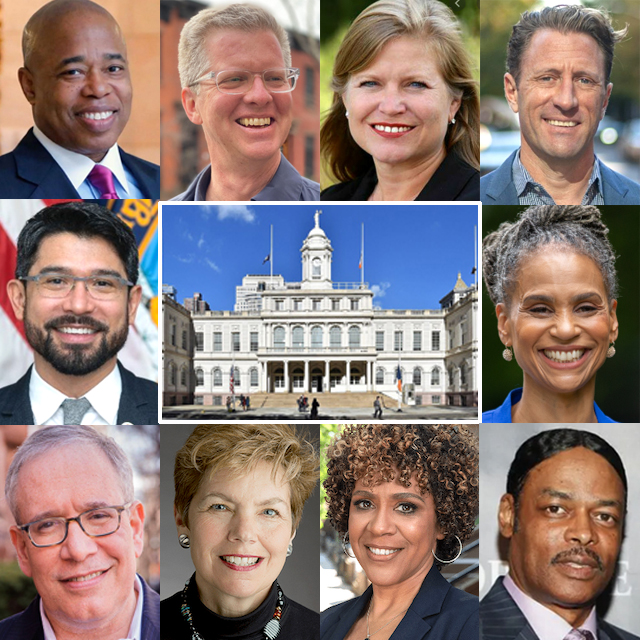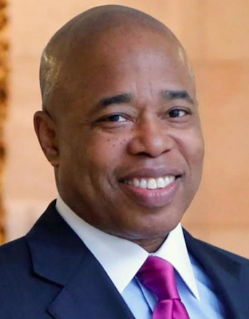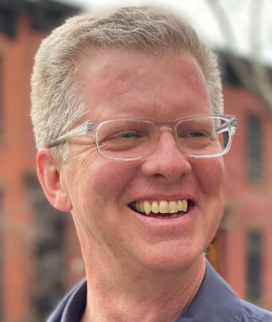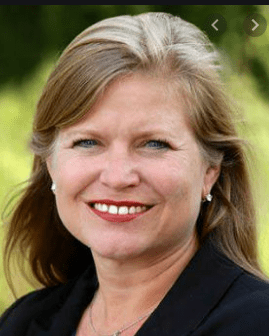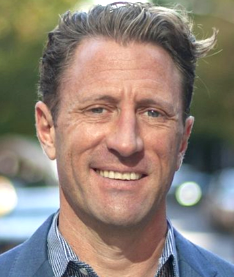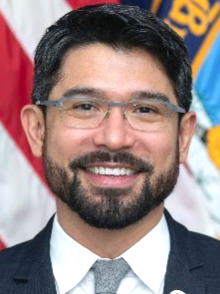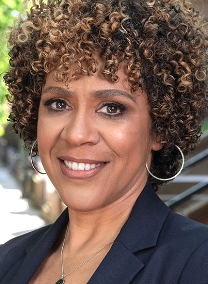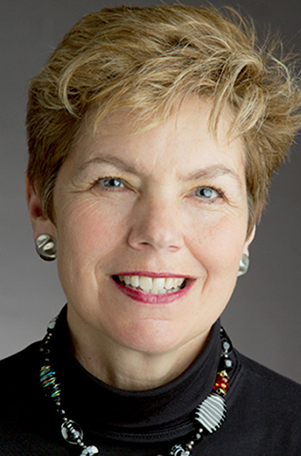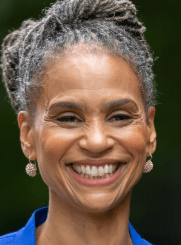
What's the path for street safety in New York City beyond Mayor de Blasio's signature Vision Zero initiative? Streetsblog asked those who would lead the city beyond COVID-19 and Vision Zero to "think big" about the question.
We asked: Is there a safety, design or enforcement strategy that is not being deployed that you think is vital to making our roadways, sidewalks and public spaces work better for everyone? How would you promote it in office? (Hint: This is a “visionary” question, so don’t think small.)
This is the last of daily rollouts of the candidates’ thoughtful and often-voluminous answers, which should provide safe-streets activists with a roadmap of where the hopefuls stand on our issues (the earlier five installments focused on safe streets, “free” parking, a car-free Manhattan, their records on stopping reckless drivers, a pledge to forsake money from fossil-fuel interests and their views on policing.) Later this week, we’ll post all seven installments in one place for easy reference.
Here is what they said:
ERIC ADAMS: The mayor has the greatest opportunity to transform our city's transportation system by repurposing our roadways. That means making SBS service the baseline for bus service and taking advantage of opportunities for true bus rapid transit. Bus Rapid Transit is cost effective, high quality, and will do the most in the shortest amount of time to build out our transit network without depending solely on New York State. We must create a BRT system that doesn't simply connect communities to Manhattan but to communities within boroughs and interboroughs.
My office is the first to put money into visionary projects like BQGreen, which would recapture land over the Brooklyn-Queens Expressway in South Williamsburg for open space. My office also advanced the PXForward plan to brainstorm ideas on how to recapture land over and along the Prospect Expressway for open space. We must do more to investigate these possibilities to identify opportunities for open space, affordable housing, schools, and a host of other community benefits that can arise from reconnecting our communities from the mistakes of the Robert Moses highway era.
According to the Design Trust for Public Space, underneath the 700 miles of elevated bridges, highways, subway and rail lines lies millions of square feet of public space — nearly four times the size of Central Park. We must be better stewards of this open space by activating it for community art, bicycle superhighways, open space, bus rapid transit and simply to combat the psychological barriers that disconnect us from our neighbors even though they may just be a block away.
We must also address our “missed connections.” That means advancing projects that may not be “visionary” but have good “bang for our buck” returns and improve mobility. For example, the Triboro Rx and the Utica Avenue Extension Plan, while not visionary, are important investments to address north-south and inter-borough connectivity. We can't abandon them. The same can be said for reopening closed subway entrances and exits, fast-tracking ADA improvements, making out-of-station transfers among station lines that are within a half mile of one another free, and making permanent (and expanding citywide) the Atlantic Ticket program that I championed in southeast Queens and Brooklyn.
I would also direct the DOT to investigate how we connect the missed connections in our cycling network, including the Harbor Ring and expanded cycling access over bridges such as the Verrazzano-Narrows. This is a simple and quick way to advance a true cycling network, even if that means using temporary infrastructure until we have capital resources to fully build out the network.
SHAUN DONOVAN: First, I will make the Open Streets program permanent and equitable. Two additional ideas that are central to my transportation platform are to launch true Bus Rapid Transit in the outer boroughs and a useful, connected network of protected bike lanes. When we build BRT in the outer boroughs, we will provide an affordable, efficient method of public transportation in neighborhoods where, right now, people are essentially required to own private vehicles and the streets are least safe for cyclists, seniors, parents/care-givers with strollers, etc. This will go a long way to radically alter the streetscape in areas where it is implemented and offer a reliable, affordable, fast public transportation option.
But it’s not enough to only deploy BRT on specific high-ridership corridors: Every bus route in the city needs improvement. I will ensure the DOT works with the MTA to deploy bus-priority lanes, queue jumps, and transit-signal priority in alignment with the MTA’s bus network redesigns. This will mean a significant scaling up of bus infrastructure on our city streets in order to safely increase bus speeds, which as you well know are the subject of primarily failing grades from the Bus Turnaround Campaign led by the Riders Alliance, NYPIRG’s Straphangers Campaign, TransitCenter and Tri-State Transportation Campaign. Increasing bus speeds and reliability begins at the streetscape, and I will make improving the bus system a core plank of my transportation effort and a priority for the DOT.
Second, in the time of COVID, the utility of cycling as a method of transportation has never been more obvious. As mayor, I will advance this work so that bicycling is seen as a safe, healthy, green method of mass transportation and not something to be dealt with at the margins after we’ve already designed streets for cars. It starts with safety. I will take a data-informed approach and focus on dangerous thoroughfares like Third Avenue in Brooklyn. I will also pay equal attention to building a functional network of protected bike lanes.
I will get the Verrazzano Bridge opened for pedestrians and cyclists, implement an upgrade to the Brooklyn Bridge pedestrian and cycling path, study road use for bikes on the 59th street bridge, build a protected bike lane in Astoria between the 59th Street and Triboro bridges, and improve bridge crossings between the Bronx and northern Manhattan. Putting paint on the asphalt and calling it a bike lane is unsafe for cyclists and another example of toothless policy that prioritizes cars. New Yorkers deserve a bike network that moves them safely — like what we see in major cities all over the world — and that is about smart design and implementation, including physical separation from traffic, and less about a total number of miles of paint.
Last, on enforcement, I will not only move transportation enforcement from the NYPD to the DOT, I will also work with the MTA to scale up automated camera enforcement of bus and bike lanes, and deploy additional speed cameras near areas with high pedestrian traffic. Automated cameras are our fairest, most reliable solution to enforcing existing traffic laws and reducing pedestrian deaths and incursions into bus and bike lanes. I am ready to work in Albany to ensure New York has all the tools available to keep us safe.
KATHRYN GARCIA: A full implementation of my Complete Streets proposal will necessitate an overhaul of public space that will optimize pedestrian traffic and public transportation. This means we can drive more pedestrian traffic to small businesses, and that New Yorkers will be able the take advantage of new ways to enjoy their communities. But there’s more we can do. We can start by regulating delivery companies like Amazon to reduce congestion, improve safety and protect workers.
We also need to kickstart planning for new transit, including the Utica Avenue and expanded Second Avenue subway to create opportunities for new housing and job growth. Finally, I believe that smart, effective transportation strategy is the foundation for housing strategy — and that the most visionary approach integrates transportation and housing planning to invest in growth in all five boroughs and bring new jobs closer to where New Yorkers live, learn and play.
ZACH ISCOL: I have experience as a founder and CEO, so big-picture thinking is a domain in which I am completely comfortable. Starting with the most intuitive fixes to save lives, we have transportation and traffic engineers — within DOT and in the private sector — who are up to the most challenging of tasks. We just need to ensure these conversations don’t happen behind closed doors and the decisions foisted upon New Yorkers.
Just look at the evolving discussions surrounding the BQE reconstruction and all of the design scenarios and proposals which have followed. This project, in addition to other citywide projects, illustrates the need for dynamic collaboration with our partners in the state and federal government and a myriad stakeholders. We must create a permanent multi-agency infrastructure task force (which does not exist right now) to ensure communication which is currently lacking as we work toward bold solutions.
First on the agenda would be getting city/state agency and placarded vehicles parked legally and not in restricted zones, completing the installation of protected bike lanes and re-developing our East River Bridges (Brooklyn, Manhattan and Williamsburg) to be pedestrian and cyclist friendly. Developing and implementing an automated traffic enforcement system will help us remove racial bias from human interactions and bring in a substantial amount of uncaptured revenue, which the city needs.
CARLOS MENCHACA: Soon, we will be confronted with a problem of private cars and trucks delivering our internet goods to our homes. COVID has increased people’s dependence on home delivery for everyday items.
We will need to think big about addressing last mile delivery. Zoning will need a massive overhaul but we can also explore other ways to decrease truck miles by building a truck-sharing network with various logistics companies to reduce large trucks and require more bike cargo delivery (hence larger bike networks for commercial use).
We can hold public hearings on designing zoning and permit language for drone corridors to carry last mile delivery items to hubs across the city. Drone technology and cargo bikes will force us to think about how we use energy, transitioning away from fossil fuels (i.e. trucks).
DIANNE MORALES: Tractor-trailers represent 8 to 12 percent of traffic in the city, but a considerably higher percentage of pollution and serious injury comes from semis.
Investing in freight rail and stationing would drastically reduce this damage, and make transportation of goods into the city cheaper.
This line left intentionally blank for spacing.
This line left intentionally blank for spacing.
This line left intentionally blank for spacing.
SCOTT STRINGER: All of my safety, design, and enforcement strategies and innovations will be in service to a single overarching goal: reducing reliance on cars in this city and maximizing public transportation, biking, and walking. That’s how we’re going to get to zero traffic deaths and injuries, and that’s how we’re going to get to better, healthier, more equitable neighborhoods.
Ultimately, transportation is responsible for 28 percent of our city’s carbon emissions and more than 550 annual deaths due to crashes or respiratory illness. So if we’re not focusing on massive reform of our transportation system, then we’re not actually interested in taking on climate change or improving public health.
Accomplishing this will take a comprehensive strategy. There is no silver bullet.
First, we need to expand the allocation of street space to pedestrians, bus riders, strollers, wheelchairs, bicycle riders, the young and the old and everyone in between. That begins with our Streets Master Plan and a more robust DOT. We’re going to challenge the status quo and utilize road and curb space for the benefit of all New Yorkers.
Second, we’re going to work with the state and federal government to scale back the 235 miles of highway slicing through our city and repurpose them for parks and greenways. We don’t have billions of dollars to spare for rebuilding and maintaining all of our decrepit and incredibly unsafe mid-century highway infrastructure. I’ve offered a plan to transform sections of the BQE into a linear park that will reduce vehicle miles traveled and bring crucial green space to our neighborhoods. That’s only a start.
Third, we’re going to pursue every opportunity to promote green transit options. I will seek to downsize the city’s fleet and work to ensure that vehicles we do purchase are powered by clean electricity.
Fourth, we’re going to hone in on commercial traffic, especially cargo and sanitation. We need to dedicate delivery zones at the curbside so trucks aren’t double parking and blocking bike and bus lanes; focus on bike safety in industrial business zones, where far too many deaths and injuries occur; dramatically expand bike delivery by loosening up state and city regulations on cargo bikes and building out needed infrastructure; make sure we have sanitation trucks that are right-sized for removing debris and snow from protected bike lanes; and implement the new Commercial Waste Zones program effectively so that we have fewer and safer garbage trucks on the road.
Fifth, we’re going to ramp up investment in bicycling and make it accessible to all New Yorkers. That will include making Citi Bike available throughout the five boroughs and free for low-income high-school kids as part of my ambitious Bike-to-School plan; initiating a massive expansion of well-designed, well-protected, well-connected bike lanes and actually investing in the maintenance of those lanes so that they’re not pockmarked with potholes, filled with trash, or covered with snow and slush; working with the state to subsidize e-bike purchases; and dramatically expanding bike parking throughout the city.
Sixth, on public transit, the bus system will be a top priority in my administration. The city controls the streets, traffic lights, curbs, sidewalk, and bus shelters (via franchise). I’m going to use that power to prioritize buses and make sure they’re fast, frequent, and reliable for the millions of New Yorkers who use them each and every day. Three years ago, I put out a comprehensive plan for improving our bus system — much of which was incorporated into Andy Byford’s Bus Action Plan. Moving forward, we’re going to take that blueprint and double down.
Finally, on trains, my agenda is three-fold. First, we’re going to integrate commuter rail into our five-borough transit system. There are 41 LIRR and Metro-North Stations in the city, locked behind an exorbitant paywall and little used by locals in Queens and the Bronx. The absolute fastest and cheapest way to improve transit access and equity in our city is to reduce commuter rail trips to the price of a subway swipe within the city and offer free transfers to the subway and bus throughout the five boroughs.
Second, we’re going to work with the MTA at the place where the city and the subway’s jurisdiction meet: the entryway. My administration will do everything in our power to help the MTA expedite the installation of elevators and other accessibility measures so that our subway system is available to New Yorkers of all ages and abilities. And we’re also going to help them reopen the more than 100 subway entryways that have inexplicably been closed over the years. Permits, inspections, supports, whatever the MTA needs to get the job done.
Last, we’re going to increase access to the subway for all New Yorkers, especially lower-income residents. Throughout our city, there are well over 100 stations with fewer than 5,000 daily riders, pre-pandemic. One of the best ways to increase ridership and improve transit access in these lower-density areas is to allow for denser development within an eighth or a fourth a mile of these stations and ensure that a large share is deeply affordable. Given the extraordinary costs of subway construction in our city, it is far, far cheaper to bring affordable housing to the subway than it is to expand the subway to more affordable neighborhoods.
This is my “visionary” plan. These strategies — and dozens of others that we’re going to incorporate by listening and learning along the way — are going to dramatically increase transit and bike ridership in this city and reduce driving. We’re going to improve access to bike lanes, bus lanes, Citi Bike, commuter rail, and subway stations in every corner of the five boroughs, creating a more equitable, more sustainable, and better transit system for a more equitable, more sustainable, and better city.
LOREE SUTTON: I’d like to hold a national, or even global, competition for a plan to re-engineer our transit grid — including its governance. We need to look for those “L train” and “14th Street bus lane” solutions, and apply that kind of creativity and innovation across the board, to create public spaces and personal and professional accommodations that work for everyone — knowing that there is far more demand for the public spaces in our city than the city can provide in pleasing everyone.
We need to have an environmentally sound strategy that results in a healthy city and dis-incentivizes carbon use and encourages walking, biking and using public transit of all kinds.
We need to repurpose the 311 hotline so that it’s not simply a receptacle for complaints, but a regular place for citizens to report their concerns and their ideas for how to do things better. Yes, please let us know about that abandoned car or a water main that’s burst, but let’s also incorporate a smart function for people who have ideas about how the transit system could work safer and better, given the demands placed on it. Further, an accountability function for closing the loop with the agency and the caller is essential.
My big idea is to stand up a Public Safety Coordination Council. This council would be comprised of the eight agencies that have key roles and responsibilities for public and street safety — the NYPD, FDNY, Department of Transportation, Department of Parks, Board of Education, Department of Correction, Emergency Management, Department of Sanitation led by the Mayor’s Office. The Council would convene regular public meetings and town halls to discuss the problems that emerge from the 311 “complaint, complement and ideas” function. The Mayor’s Office of Operations would serve as the integrator to bring these agencies together and synchronize actions.
This Public Safety Coordination Council would be structured to extend the design and function of the CompStat system, originally implemented within the NYPD, to PSCC member agencies as well — to enhance transparency, accountability and public safety outcomes citywide. With monthly working meetings and quarterly town halls, the PSCC would facilitate feedback loops between citizens and relevant city agencies, and broadening the opportunity for citizens to communicate their concerns to city government and participate in their resolution.
MAYA WILEY: Our city’s physical infrastructure, much like our housing, has been shaped by legacies of systemic disinvestment and over policing. Many live in transit starved communities. Communities of color wait longer for repairs to their streets. New Yorkers, especially immigrants, people of color, and people experiencing homelessness are over-policed in routine traffic and sidewalk stops. In 2019, 90 percent of NYPD summonses for jaywalking were given to Black or Latinx people. As the Brookings Institution has noted, communities of color disproportionately face higher pedestrian casualties.
Communities must be engaged in the physical redesign of their neighborhoods. Safe streets require significant investment of both resident input and infrastructure, which have bypassed communities of color for too long. Our city needs to invest in what residents actually want and need to make their public spaces safer. We need to consider street redesign elements such as protected cross-walks, bike lanes, and BRT bus lanes that make streets safer for residents and make transit a real option to getting drivers out of cars.
These infrastructural investments, like speed cameras, are proven to be more effective enforcement measures than police-based oversight. Research by Transportation Alternatives Shows that street enforcement cameras reduce speeding by 63 percent and traffic fatalities by 55 percent. A DOT study of the Prospect Park West bike lane in Brooklyn showed that the introduction of a protected bike lane led to a 94 percent drop in cycling on the sidewalk. Investment in better infrastructure, rather than arbitrary traffic stops, will make our streets safer.
ISAAC WRIGHT, Jr.: An Isaac Wright, Jr. administration will prioritize fixing the city’s history of redlining, which severely impacts the way people move around the city.
I don’t think this is a "visionary" question at all; I think this is a basic decency question, and if New York City is going to stake its claim as the greatest city in the world, we need to ensure every single one of its residents has easy access to public transit.
Planning must be geared toward alleviating any and all mobility constraints that continue to prevent equitable usage of the city's public space and resources.
That basic step is the most impactful we can realistically take, and it’s one I’ll prioritize as mayor.
